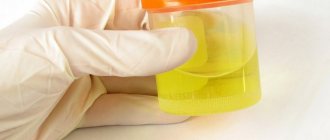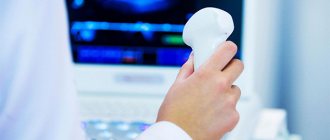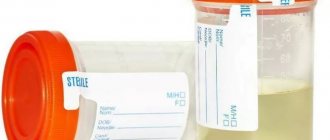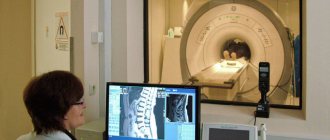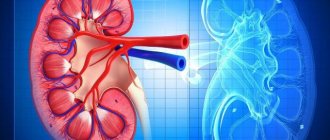Ultrasound examination is one of the most reliable diagnostic methods.
The technology allows an ultrasound doctor to assess the condition of organs and tissues, identify deviations from the norm, clarify the localization of an inflammatory or other pathological process, the location and size of a tumor, and diagnose various diseases. The accuracy of ultrasound results is influenced by several factors, including proper preparation for the examination. If the recommendations are not followed, the image obtained using an ultrasound machine may be distorted.
It is important to know how to properly prepare for an ultrasound of the bladder and kidneys.
What does an ultrasound of the kidneys and bladder show?
During the procedure, the doctor can diagnose:
- injuries and malformations of organs;
- acute and chronic diseases of the kidneys and bladder;
- stones, various neoplasms in the urinary system.
Using an ultrasound, a specialist evaluates the size, shape, location, mobility of organs, identifies abnormalities in tissue structure, and the presence of space-occupying formations. The following reminder for preparing for an ultrasound of the kidneys and bladder will help you obtain reliable diagnostic results.
Is it possible to eat before an ultrasound of the kidneys and bladder?
The list of foods that can be eaten before a kidney ultrasound for 2 days is limited to simple, light food that does not form gases in the intestines. You cannot eat directly on the day of the test, so it is usually prescribed in the morning. If you are scheduled for an examination during the day or evening, your last meal should be no later than 6-8 hours before the ultrasound.
You can have breakfast before a separate examination of the bladder, but not before an ultrasound of the kidneys or a comprehensive examination of the urinary system.
Preparation
Preparing the patient for an ultrasound scan of the kidneys and adrenal glands is necessary in order to eliminate possible interference from the intestines and other organs. The existing air in the intestinal loops creates an obstacle to the passage of ultrasound. This distorts the results. Doctors' recommendations usually concern diet before the study. 2-3 days before the procedure, avoid foods that cause flatulence (bloating).
What not to eat before a kidney ultrasound:
- legume products - beans, peas, lentils;
- fruits and vegetables without heat treatment;
- meat broth;
- whole milk;
- carbonated and alcoholic drinks;
- sausage, smoked and fried meat;
- fatty fish;
- Rye bread;
Allowed diet before kidney ultrasound:
- buckwheat, oatmeal, pearl barley porridge, cooked in water without adding milk;
- boiled fish;
- Hard boiled egg;
- boiled lean meat, steam cutlets;
- unsalted hard cheeses;
- crackers or dried bread;
This preparation regimen for kidney ultrasound examination is maintained for 2–3 days. If the patient has increased gas formation, the diet needs to be followed longer (up to a week). To reduce flatulence, it is recommended to take sorbents.
To prepare for a kidney ultrasound, the patient needs to familiarize himself with the main measures aimed at improving the visualization of organs during the examination:
- If you are prone to flatulence for 2-3 days, it is recommended to consult with your doctor and start taking enzymes (Pancreatin, Mezim) with meals. These drugs make digestion easier. In addition, drugs belonging to the group of sorbents (Espumizan, Infacol for infants, Enterosgel, Smecta) which help reduce the formation and removal of gases from the intestines, thereby creating a good ultrasound window for diagnosis.
- The night before or the morning of the procedure, you should try to get stool and empty your bowels.
- If necessary, do a cleansing enema. It is preferable to use laxatives (Guttalax, Picolax). You can make a Microlax microenema or put on a glycerin suppository.
- You must arrive for the procedure on an empty stomach. On the eve of the session, a light dinner is allowed no later than 7 pm. If the study is planned for the daytime, a light breakfast and water are allowed early in the morning. 1.5 hours after eating, take 6-8 tablets of crushed activated carbon mixed with water. You are not allowed to smoke 2 hours before the session.
Do I need to take fluids before the test? Considering the fact that diagnostics of the urinary system, as a rule, also includes an examination of the bladder and ureters, preparation for the procedure requires drinking 500 ml of water 40–60 minutes before the session. It’s even better to come to the procedure with a bottle of water and drink it gradually. Diagnosis is carried out as soon as the desire to urinate appears.
It must be remembered that following the doctor’s recommendations, the patient helps to obtain accurate ultrasound results.
Preparing pregnant women
During gestation, the urinary system experiences a heavy load, and in the presence of toxicosis, these organs are the first to suffer. During this period, you can often see the presence of such a diagnosis as nephropathy in pregnant women. Considering the “interesting” condition of the woman and the many restrictions during this period, diagnosis of diseases is only possible with the help of ultrasound.
Attention! It is not advisable for pregnant women to use sorbents and laxatives. They can harm the baby and affect the tone of the uterus.
Women's preparation consists of following a diet that prevents the formation of gases. If you plan to check only the kidneys, there is no need to follow the diet. During a complete examination of the abdominal cavity, it is recommended to abstain from foods that cause flatulence, and before the session it is recommended to take 500–700 ml of water.
Preparing the child
Screening of newborn children aged 1–1.5 months includes ultrasound diagnostics to exclude congenital pathology. To prepare, it is enough for babies to adhere to the general rules of following a diet that does not allow gas formation (if the child is breastfed, the mother is advised to refrain from foods containing fiber). For flatulence, give Plantex, Espumisan or Bobotik. For newborn children, the study is carried out regardless of bladder filling. Babies under 1 year of age are fed formula or given water 20 minutes before the procedure. Young children are asked to relieve themselves 2 hours before the ultrasound, after which they are given liquid. To fill the bladder, you need to calculate the amount of water you drink depending on your age:
- 100 ml – up to 2 years;
- 200 ml – from 2 to 7 years;
- 300 ml – from 8 to 11 years;
- 400 ml - over 11 years
What not to eat before an ultrasound of the kidneys and bladder
The diet before ultrasound of the kidneys requires excluding from the diet:
- Rye bread;
- fresh fruits, cabbage and other green leafy vegetables;
- alcohol and carbonated drinks;
- products with artificial sweeteners;
- and so on, which can cause the release of large amounts of gas in the intestines.
People with sensitive digestion are advised to avoid foods high in carbohydrates, fried and fatty foods: they can also cause increased gas formation.
If there is a volumetric accumulation of gases, the ultrasonic wave from the sensor will not be able to reach the required depth, which will distort the examination results. How much water to drink before an ultrasound of the kidneys and bladder
Ultrasound of the bladder is performed only if it is full. An hour before the organ examination, you need to drink 1–1.5 liters of water or any other liquid. The same rule applies to complex studies of the urinary system. You can urinate only after the procedure is completed.
Is it possible to drink water before a kidney ultrasound? If during the examination the ultrasound doctor looks only at the kidneys, there is no need to fill the bladder. Immediately before the examination, it is advisable to limit yourself to 100 ml of clean water.
You can drink tea and coffee before a kidney ultrasound
Tea and coffee are considered food, and the study is carried out on an empty stomach. Drinking these or any drinks on the day of the ultrasound is not allowed.
What you can do before a kidney ultrasound: diet before the procedure, how much water to drink
Kidney ultrasound is a non-invasive way to obtain images of the paired organ.
Unlike X-rays, ultrasonic waves do not cause actual damage to the body. In addition, ultrasound scanning of the kidneys usually does not require long-term bowel and bladder preparation. Therefore, to the question “is it possible to eat before an ultrasound of the kidneys?” a positive answer is given. Rather, the doctor can warn about a special drinking regime.
What can and cannot be eaten?
As mentioned above, the question of whether it is possible to eat before an ultrasound scan of the kidneys is given a positive answer. No special diet or even fasting is required. But if an additional examination of the entire abdominal area is carried out, the doctor will tell you what you should not eat before an ultrasound scan of the kidneys.
And yet, if the examination was scheduled not for early morning, but after lunch, it is recommended to refuse food:
- adult patients should not eat 6 hours before the procedure;
- children under 5 years of age should not eat within 4 hours;
- For babies under one year old, it is enough to refuse food for 2 hours;
- For diabetics, as well as during pregnancy, nutrition should not be radically changed. Therefore, you just need to inform the doctor that even the simplest diet before an ultrasound of the kidneys is contraindicated, and ask to schedule the procedure for the earliest possible morning.
Recommended drinking regimen
It is not so important whether to undergo an ultrasound scan of the kidneys on an empty stomach or not. But the drinking regime should be observed. The doctor will usually tell you whether you need to drink extra fluid before the ultrasound scan or whether your bladder needs to be empty.
If the specialist did not say whether you should drink water before an ultrasound scan of the kidneys, then you should stick to your usual drinking regimen.
But since the bladder is usually examined along with the kidneys, patients are advised to come to the procedure after drinking at least a liter of water.
It is best to go to the toilet about an hour before the start of the procedure, and drink a liter of water about 15-20 minutes before entering the office.
Children aged 10 years (and younger) should drink 500 ml of water 1 hour before the ultrasound examination. However, not everyone can go even 15 minutes with a full bladder.
Such people just need to come to the hospital early and drink the required amount of liquid right outside the office. Waiting your turn “without moving” with a full bladder is quite comfortable. It is much more uncomfortable to move actively.
If the time for taking the liquid is calculated incorrectly, it will be quite problematic to endure the procedure without wetting yourself.
Having figured out whether you can drink before an ultrasound of the kidneys, you need to understand what specific liquids are recommended. It is best to drink plain clear water without gas. It is water that will allow you to visualize the boundaries of organs as efficiently and accurately as possible.
Ultrasound of the bladder in women: how to prepare
General recommendations on how to properly prepare for an ultrasound of a woman’s kidneys are presented above. It is also advisable to take into account the menstrual cycle when choosing the date of the study. When asked whether it is possible to do an ultrasound of the kidneys during menstruation, most doctors answer negatively. It is better to wait until the end of the critical days, since blood clots can distort the ultrasound result.
Is it possible to do an ultrasound of the kidneys during pregnancy?
Ultrasound diagnostics is absolutely safe for the fetus and the body of the expectant mother. Ultrasound is allowed at all stages of pregnancy.
Preparing a child for an ultrasound of the kidneys and bladder
Many mothers do not understand how to prepare their child for an ultrasound of the kidneys and bladder if he cannot drink a liter of water. This volume is usually not needed.
The amount of fluid required to fill a child's bladder is calculated using the formula 5–10 ml per 1 kg of weight. That is, for an average 6-year-old child who weighs 20 kg, only 200 ml of water is enough. Immediately before the procedure, the child should feel the urge to urinate.
An infant can be fed 2 hours before the examination, after which only water can be given. It is important that the baby is calm during the procedure, so it is worth taking a pacifier or pacifier to the ultrasound room.
Return to list
How to properly prepare for a kidney ultrasound
Before almost any research method, it is necessary to carry out certain preparatory measures. An ultrasound of the kidneys is no exception; preparation for the examination of these organs will help the doctor conduct a more complete and high-quality examination.
A little anatomy
- The kidneys are a paired organ of the urinary system, located in the retroperitoneal space at the lumbar level on either side of the spine.
- The right kidney is located slightly lower than the left, because anatomically it is pushed downwards by the liver.
- Most often, bean-shaped buds are found, but there are two more normal variants:
- “lobulated” kidney, found in children;
- A “humpbacked” kidney is formed during intrauterine development due to pressure on it from the spleen.
An important stage of the study is to determine the size and volume of the kidneys depending on age. The norms for children are presented in the table:
| Age | Length, cm | Width, cm | Thickness, cm |
| Newborns | 4–5 | 2,5–2,7 | 2–2,3 |
| 1 year | 5,5–6,5 | 3,5–3,7 | 2,5–2,7 |
| 5 years | 7,5–8,5 | 4–4,3 | 2,8–3,0 |
| 10 years | 8,5–10 | 4,5–4,8 | 3,3–3,8 |
If the size of the kidneys does not coincide with normal sizes, then the doctor pays attention to the height and weight of the child and evaluates the indicators using special tables regarding his build.
The size of the kidneys in an adult varies within the following limits:
- length 9-12 cm;
- width 4.5-6 cm;
- thickness 3.5-5.5 cm.
The most accurate indicator is the volume of the kidneys, which is closely related to the body composition of a child or adult. It is determined by the formula: length × thickness × width × 0.52.
Also, when performing an ultrasound, the doctor determines the blood flow in the renal artery, which, if disturbed, can cause arterial hypertension. In this case, it is very important to know how to prepare for a kidney ultrasound.
It should be noted that in the retroperitoneal space this paired organ is supported only by the surrounding fatty tissue, therefore, with sudden weight loss and thinning of the adipose tissue around the kidneys, they can change their position, that is, descend. Depending on the degree of prolapse, disruption of their functioning may occur.
The location of the kidneys allows them to be in close contact with many organs of the abdominal cavity, including the intestines. Anterior to them lies the large intestine, which under certain conditions can be an obstacle to examination.
Preparing for a kidney test
Preparation for a kidney ultrasound in women is no different from that in men. All preparatory measures are aimed at improving the so-called ultrasonic window, that is, so that there are no obstacles for inspection. Since the main difficulty may be a crowded and gassed intestine, it is necessary to improve its functioning before the study.
Diet
Everyone knows that there is a list of products that are not recommended to be consumed before various diagnostic procedures. These include:
- legumes (peas, beans, lentils);
- cabbage, radishes, turnips, potatoes;
- any porridge except rice;
- bread;
- some fruits (apples, pears, grapes);
- carbonated drinks;
- dairy and fermented milk products, including ice cream.
- This is a generally accepted list of foods that contribute to the development of flatulence, from which you should start.
- Each person is individual, so for one an apple will cause a “storm” in the intestines, while for another it will help normalize its functioning.
- You should also pay attention to the variety of fruits and vegetables available, some of which increase gas, others not.
- This means that preparing a patient for a kidney ultrasound should have an individual approach; there is no need to blindly follow generally accepted recommendations.
- You should change your diet at least 2-3 days before the ultrasound, and preferably a week.
- There are situations when it is not possible to get rid of flatulence through diet. Then you can use special medications, including:
- sorbents that collect not only toxins, but also excess gas;
- defoamers, which promote the transition of gas in the intestines from foam into separate bubbles, due to which they are better excreted;
- combination drugs, for example, enzymes with antifoams.
The drugs from the last point will not only improve the passage of gases, but also promote digestion.
Normalization of stool
If the intestines are full of feces, then there will be gases there regardless of the diet, and the contents themselves will interfere with the examination.
Foods that contribute to constipation:
- dairy;
- strong coffee and tea;
- sweets and chocolate in large quantities;
- baking;
- fast food;
- fatty meats;
- astringent fruits.
This list is also not perfect because it is based on the majority. In this case, you need to reduce the amount of those foods that cause problems with stool in a particular person. For example, if strong coffee does not cause stool consolidation, then there is no need to exclude it.
Sometimes a more drastic approach may be required, such as taking laxatives. Such drugs can be taken in the evening, on the eve of the test, so that you have stool in the morning.
If you do not want to use medications, then it is possible to perform an enema with a volume of about 300 ml with water at room temperature. This procedure cannot be performed on the eve of the ultrasound; it is better to do it 2 days before the examination.
Knowing how to prepare for an ultrasound of the kidneys is also necessary for examining the ureters.
Eating
Many people are interested in whether it is possible to eat before an ultrasound scan of the kidneys. There may be several options here:
- If a kidney examination is performed as part of an ultrasound of the abdominal cavity and retroperitoneal space, then you should not eat before the examination.
- If the doctor has prescribed only an ultrasound of the kidneys, then you can eat. Food eaten before the test will not affect the condition of the kidneys and will not interfere with seeing them, since it will be in the stomach.
